Also see: Rialto Theatre - interior views
Architect: Oliver P. Dennis. The building is 9,830 square feet.
Seating: 1,000 originally, 840 in later years. It was an early stadium-style layout with the upper section of seats above the lobby.
An article in the Moving Picture World issue of June 23, 1917 described the opening:
"A huge electric sign representative of flickering candles and with the emblazoned words 'Quinn's Rialto,' at the top of the theatre structure, gives the theater its place in the sun on the local Broadway. Selig's multiple reel feature, 'The Garden of Allah," has drawn capacity audiences from the first day of the opening. Mr. Quinn was the recipient of many floral tributes from his many friends upon the ushering in of his newest venture. Through Irving Lesser of the All Star Feature Distributors, Mr. Quinn bought the entire rights for Los Angeles for 'The Garden of Allah.'"
Thanks to ace theatre detective Cezar Del Valle for finding the article and including it in a post on his Theatre Talks blog. Another account of the opening once posted on the LAHTF Facebook page comes from an unknown source:
An undated view of J.A. Quinn from the collection of his grand-daughter Marlaine Wilson Hysell. Quinn was also involved in the Superba Theatre and the Garrick, among others. The Superba site is now occupied by the Roxie. The Garrick was demolished to make way for the Tower Theatre. Head down to the bottom of the page on Quinn's Superba for a timeline of his exhibition career.
A column of ads from June 1917 included the Rialto, still running their opening attraction, "The Garden of Allah." Thanks to Ken McIntyre for locating this.
In an October 1919 telegram from Grauman to Adolf Zukor in New York he mentions that he is
In one program, the renovated Rialto was advertised as "The World's Most Beautiful Little Theatre." Hillsman Wright, of the Los Angeles Historic Theatre Foundation described the theatre after the Grauman makeover:
Hillsman speculates that because of the lack of space at the Rialto, some or all of the cast for the elaborate prologues were based at the Million Dollar and bused down Broadway to the Rialto. This would be much like what was depicted in the film "Footlight Parade" (Warner Bros., 1933) where they're using the same cast and changing costumes in the bus as they rush from theatre to theatre to stage James Cagney's Grauman-like prologues before the feature films. Perhaps not coincidentally, even though the film is set in New York, we get a view of the Million Dollar Theatre as we speed by.
"Where the Big Pictures Play." A November 30, 1925 ad in the Times for "Pony Express." No mention of Grauman in this particular ad.
A March 1926 article about the takeover of the theatre by L.E. Cohen and M. H. Schulkin. Thanks to Ken McIntyre for locating this for a Rialto thread on the Photos of Los Angeles private Facebook group.
That "H" as Schulkin's middle initial was a typo. His middle name was Arnold. The L.E. Cohen mentioned in the article was Lawrence E. Cohen (d.1944). He and his brother Sherrill were the sons of family head Joe H. The family soon changed their name to Corwin. It's unknown when or under what circumstances the Schulkin family was eased out of the business.
A post-war renovation gave the lobby a swirling Skouras-style look. According to theatre historian Ed Kelsey the building had a seismic retrofit in 1983 and received another renovation in 1984 that removed most of the remaining historic details.
Closing: The Rialto closed as a theatre in 1987 with Metropolitan Theatres as the final operator. The lobby was converted to retail space and what had remained of the theatre interior was gutted. In 2008, a $6 million remodel was proposed to re-light the Rialto as a restaurant/bar/live music venue. Nothing happened with those plans.
Status: The reopening of the building as an Urban Outfitters store was in December 2013. They have a long term lease and did a terrific job restoring the marquee, the longest downtown. The marquee is the only part of the building that is effectively landmarked. Supposedly the boxoffice was landmarked as well but that didn't stop it from disappearing.
Hillsman Wright notes that early in the process one of Urban Outfitter's contractors had been furnished vintage photos of the sign for study. This wasn't the first theatre project for the company. The chain evidently did a great job of adaptive reuse of the Garden Theatre in Charleston.
More exterior views:
1917 - Putting up the letters for the theatre's inaugural attraction, "Garden of Allah." Thanks to intrepid researcher Ken McIntyre for finding the photo for a post for the private Facebook group Photos of Los Angeles.
1917 - The Rialto shortly after the opening. The photo appeared with the June 23 Moving Picture World article that described the theatre's debut. Thanks to Brooklyn-based theatre historian Cezar Del Valle for finding the article for a post on his Theatre Talks blog.
1917 - The Rialto with a big crowd for "The Whip." The film was a March release about a racehorse named Whip. Thanks to Dallas Movie Theaters for the photo from a trade magazine. It was a contribution of theirs to the Cinema Treasures page about the Rialto.
1917 - A big crowd at the Rialto for "Polly Of The Circus," a September release with Mae Marsh. Thanks to Ken McIntyre for posting the photo on the Photos of Los Angeles private Facebook group.
c.1920 - A lovely shot looking north toward 8th. On the right toward the end of the block we get a slice of Grauman's Rialto and beyond, at 8th and Broadway, the Garrick, now the site of the Tower Theatre. Across 8th is the Chapman building, still there. On the extreme left of the photo we have a glimpse of Tally's Broadway with Hamburger's Department Store beyond.
The photo is on Brent Dickerson's chapter Later Around Broadway and 8th. This multi-part Broadway tour is one of many great adventures on Brent's "A Visit to Old Los Angeles" epic that appears on the Cal State Long Beach website. Details are on the site's index page. A version of the photo also appears on the Photos of Los Angeles Facebook group.
1920 - Grauman's Rialto during the 3rd week of the run of the Mary Pickford film "Suds," a January release. The photo from someone's scrapbook went for $8.95 on eBay. Thanks to Kurt Wahlner for finding this gem. Visit GraumansChinese.org, his amazing website about another Grauman theatre.
1920 - A big crowd for "The Restless Sex," a September release starring Marion Davies. Thanks to Dallas Movie Theaters for the photo, a contribution of theirs to the Cinema Treasures page about the Rialto.
1922 - A drawing giving us a look at the new California Music Company Building, a design by Meyer & Holler that was later renamed the Singer Building. On the left it's the Garrick, on the right the Rialto. Thanks to Brent Dickerson for the image. It's included in his Later Around Broadway and 8th chapter.
1923 - A Los Angeles Public Library photo with the Garrick Theatre on the left, the Southern California Music Co. Building in the center, and the Rialto on the right. Harold Lloyd's "Why Worry?" is at the Rialto, a December engagement. Note the reworked roof sign, here saying "Grauman's Rialto." The film at the Garrick, "Beyond the Rocks," appears to be a return engagement. It had played the Alhambra on Hill St. in June 1922.
1924 - A view with Rialto on the right playing Harold Lloyd's "Hot Water," an October release. It's a photo in the California State Library collection. Note the absence of a roof sign. The newly remodeled facade lost the classical pediment and most of its windows. On the right it's the new Wurlitzer Building.
1925 - The facade done up as The Big Show for D.W. Griffith's circus epic "Sally of the Sawdust." The photo appeared in the October 31, 1925 issue of Motion Picture News with this caption: "Frank Newman got real display results on 'Sally of the Sawdust' (United Artists) at the Rialto, Los Angeles. The authorities don't permit cut-outs on the streets so Newman mounted them on net and hung them back of the street line." It's on Internet Archive.
1927 - A wire walker on the marquee. The Rialto's feature is "The Rough Riders," a film that had opened first-run at the Million Dollar on June 6. By July it was at the Rialto. In their July 24 issue the Times noted that the Rialto was running it. It's a Los Angeles Public Library photo.
1927 - Another wire walker shot. Note the construction signage for the Tower Theatre. It's a Los Angeles Public Library photo.
late 1920s - A glorious postcard looking up Broadway from Cezar's Del Valle's collection. We get the Rialto marquee on the right. Beyond you can see the Tower marquee noting that they're "Featuring Vitaphone." Thanks, Cezar! Check out his Theatre Talks blog to learn of his latest investigations.
1928 - A C.C. Pierce view looking south on Broadway. We get the Tower, Rialto and, a bit farther down the block, the "new" Orpheum. The photo is in the Huntington Digital Library collection.
1928 - A detail from the C.C. Pierce photo above.
1929 - A Christmas view north toward 8th from the Dick Whittington Studio. On the right we get a bit of the Rialto marquee followed by the Tower and the President/Globe. Over on the left in the distance there's Loew's State and the Broadway entrance to the Paramount Theatre (the former Metropolitan). The photo in the USC Digital Library collection is one in a set of seven photos surveying Christmas decorations that year. Thanks to Stephen Russo for finding the set on the USC site.
1931 - Looking south on Broadway at the Tower, Rialto and Orpheum. The Rialto was playing Chaplin's "City Lights," a moveover from the Los Angeles. At the Tower it was the April release "Bachelor Apartment" along with Helen Twelvetrees in "Millie," out in February. The photo is in the Los Angeles Public Library collection.
1942 - We're shopping at the May Co. Out the doors across Broadway we see Betty Grable and Victor Mature in "Song of the Islands." The second feature looks like Dorothy Lamour and William Holden in "The Fleet's In." It's a Los Angeles Public Library photo. Thanks to Michelle Gerdes for finding it in the Library's collection.
1944 - A look south at the Tower, Rialto and Orpheum. At the Tower it's "Cry Havoc!'" with Margaret Sullavan, Joan Blondell and Ann Sothern. It was a February release. The bottom half of the bill is "Pinup Girl" with Betty Grable and John Harvey. Thanks to Sean Ault for finding the photo on eBay. Ron Whitfield also had a version posted on the private Facebook group Photos of Los Angeles.
1946 - The Rialto running "Tomorrow is Forever." Note the Tower Theatre at the left -- during this period called the Music Hall. It's a photo in the Herald Examiner collection at the Los Angeles Public Library. They nite that the image is of the first Yellow Car to roll down Broadway after a transit strike.
c.1950 - A look at part of the 800 block of Broadway with the Rialto off to the left. To the right of the theatre is the Wurlitzer Building (1924, Walker & Eisen) and, nearest us, the Brown-Israel Outfitting Co. Building (1922, Benjamin Bloser). Thanks to Ken McIntyre for the photo, appearing as a post on the Photos of Los Angeles private Facebook group.
1953 - The Tower is seen here in its Newsreel Theatre days. The Rialto down the Street is running "The Moon is Blue" with William Holden and David Niven. The photo from the Jack Finn collection appears on the website of the Pacific Electric Railway Historical Society.
1972 - The theatre as a Spanish language film house. It's a Los Angeles Public Library photo.
1970s? - An undated photo from the Herald Examiner collection at the Los Angeles Public Library collection giving us a view north on Broadway during a light traffic day.
1976 - Thanks to Bill Gabel for this shot, a contribution of his to the Cinema Treasures page about the Rialto.
1979 - Thanks to Ken McIntyre for this great view, a post of his on the Photos of Los Angeles private Facebook group.
1980 - Thanks to the now-vanished American Classic Images website for this fine shot.
1986 - A photo from the Los Angeles Conservancy archives that appeared in a Broadway photo gallery that was once on the organization's website.
1986 - A shot located by Ken McIntyre for a post of on the Photos of Los Angeles private Facebook group. The Rialto closed in 1987.
1995 - A nice shot appearing on the Grace Marketing Research Broadway Theater Tour. The site also has a great Hollywood Studio Tour.
2007 - The south end of the marquee. Photo: Bill Counter
2007 - The letters were still up (more or less) for "La Sirena de Millon Dolares." It's visible in at least 4 movies from "The Mambo Kings" (1992) through "End of Days (1999). Thanks to Ken McIntyre for sharing his photo as a post on the Photos of Los Angeles Facebook group.
2008 - Thanks to Stephen Friday for his photo on Flickr. It's from his terrific 75 photo East Side of Broadway set.
2012 - A look south on Broadway at the Tower, Rialto and Orpheum theatres. That's the Singer / Southern California Music Co. Building in between the Tower and the Rialto. The structure beyond the Rialto is the Wurlitzer Building. Photo: Bill Counter
2012 - A closer view looking south toward the theatre. Photo: Bill Counter
2012 - The north end of the marquee and a bit of the May Co./ Broadway Trade Center. Thanks to Ken McIntyre for his photo on the Photos of Los Angeles private Facebook group.
2012 - A man and a theatre awaiting better days. Thanks to Yasmin Elming for her photo on the LAHTF Facebook page.
2012 - The view north from the Orpheum. Photo: Bill Counter
2012 - The Rialto, the Singer Building, and the Tower Theatre as we look north toward 8th St. Photo: Bill Counter
2012 - A detail of the south corner of the marquee with the bonus of a bit of the Wurlitzer Building. It's a photo Ken McIntyre shared with the Photos of Los Angeles private Facebook group.
2012 - A lovely night view north on Broadway. Photo: Hunter Kerhart. Thanks, Hunter! Keep up with his latest explorations: HunterKerhart.com | on Flickr
2012 - Deserted at night. Thanks to Stephen Russo for his photo on the LAHTF Facebook page.
July 2013 - Making a pattern from some of the surviving tubing. Thanks to Gary Callahan for his photo from the LAHTF Facebook page.
July 2013 - Chris Nichols noticed the sign work on the Rialto in preparation for the new tenant Urban Outfitters. He covered it in an August 2 Los Angeles Magazine story discussing what's happening downtown: "Urban Outfitters Bringing Big Changes To Downtown Los Angeles."
September 2013 - Brigham Yen's DTLA Rising story: "Urban Outfitters Coming Soon..." included this shot of work underway on the marquee. Also see his December 2013 story about the store's opening for a number of interior views.
November 5, 2013 - The white base coat on the Rialto's sign. Photo: Hunter Kerhart
November 6, 2013 - Old paint and new: work on the south readerboard. Photo: Hunter Kerhart
November 12, 2013 - Making the south readerboard colorful again. Thanks to Escott O. Norton for his photo on the LAHTF Facebook page.
The Los Angeles Historic Theatre Foundation is actively involved in the study and preservation of the many vintage theatres in the L.A. area. The group frequently supports events and offers tours. www.lahtf.org | on Facebook |
November 14, 2013 - The neon back up on the south readerboard as the Urban Outfitters opening neared. Photo: Hunter Kerhart
November 21, 2013 - The Rialto marquee at dusk. Photo: Hunter Kerhart
November 24, 2014 - New neon tubing getting installed on the marquee. Thanks to Wendell Benedetti for his photo, a post on the LAHTF Facebook page.
November 24, 2013 - More details of the marquee work by Romeo Sign Service. Thanks to Wendell Benedetti for his photo on the LAHTF Facebook page. More 2013 views on the LAHTF Facebook page: night before opening - 12/18 - Stephen Russo | from the south - 12/18 - Russo | lighting ceremony - 12/18 - Benedetti | marquee lit - 4 views - 12/3 - Norton | from the south - 11/12 - Escott O. Norton |
December 2, 2013 - A look at the neon colors at the north corner. Photo: Hunter Kerhart
December 2, 2013 - The reborn Rialto marquee on its first night. Photo: Hunter Kerhart
December 2, 2013 - A closer look at the front readerboard. Photo: Hunter Kerhart
January 25, 2014 - A big night on Broadway with the Rialto, Tower and Globe marquees lit. The event was the "Day on Broadway" celebrating the 6th anniversary of the city's Bringing Back Broadway initiative. Photo: Hunter Kerhart
January 2014 - The Rialto from across Broadway. Photo: Hunter Kerhart
2015 - A fine neon detail by Sh8dyone on the Bringing Back Broadway Facebook page.
2017 - A marquee shot from Ken McIntyre shared with the Photos of Los Angeles private Facebook group. Yes, the scaffolding was still up in front of the Singer Building.
2017 - A detail of the south readerboard. Thanks to Ken McIntyre for sharing his photo, added as a comment to a post on the Photos of Los Angeles Facebook group.
2020 - The marquee glowing brightly again in February after some maintenance work. Some of the neon elements and readerboard sections had not been working. Photo: Bill Counter
Around the back:
1977 - Thanks to Ted Wright for this look at the back of the theatre. The sign is advertising the Tower Theatre, then called the Newsreel. The photo appeared as a post from Ted on the Photos of Los Angeles private Facebook group.
1978 - Thanks to Tom Zimmerman for this photo of the back of the Rialto. It's in the collection of the California State Library.
2007 - The rear of the Rialto Theatre building. Photo: Bill Counter
2012 - The rear of the Rialto from Spring St. Orpheum Theatre owner Steve Needleman's company, Anjac Fashion Buildings, owns most of the block with the exception of the Rialto and Tower Theatre properties. Photo: Bill Counter
2017 - A look west across the Rialto toward the Hamburger / May Co. / Broadway Trade Center building during its exterior restoration. Thanks to Bao Le for his photo, a post on the DTLA Development Facebook group.
We get a wild ride down the 800 block of Broadway near the end of Harold Lloyd's "Girl Shy" (Pathé, 1924). The marquee and facade of the Rialto are on the far right with the Garrick Theatre beyond. See the Historic L.A. Theatres in Movies post for more shots of the block with glimpses of Tally's Broadway, Majestic and Mission theatres. There are also views of the Culver City Theatre and the Granada/Oriental on Sunset Blvd.
The opening of "Three Daring Daughters" (MGM, 1948) is set in New York but about 10 minutes in we're seeing the Rialto, the Orpheum, and the vertical of the United Artists out the back of a cab. Jane Powell, Ann E. Todd and Elinor Donahue as the daughters. Jeanette MacDonald is the mother and Jose Iturbi plays himself as a new husband. Fred M. Wilcox directed. See the Historic L.A. Theatres in Movies post for several more shots from the film.
The Tower, Rialto and Orpheum appear briefly in Sidney Poitier's "Let's Do It Again" (Warner Bros./First Artists, 1975) although we're supposedly cruising around New Orleans.
We see lots of downtown Los Angeles including the Rialto and the Orpheum while Nick Nolte and Eddie Murphy are supposedly driving around San Francisco in Walter Hill's film "48 Hrs." (Paramount, 1982).
Antonio Banderas is in New York City reading a book on the street as his friend passes out flyers for his musical event at the Empire Ballroom in Arne Glimcher's "Mambo Kings" (Warner Bros., 1992). Behind him we get the north side of the Rialto marquee. On the Rialto marquee: Esther Williams in "La Sirena de Millon Dolares" ("Million Dollar Mermaid," 1952). See the Historic L.A. Theatres in Movies post for more shots from the film, including interior views of the Tower.
It's uncertain what city we're supposed to be in but we end up on Broadway in Nick Cassavetes' "She's So Lovely" (Miramax, 1997) with Sean Penn and Robin Wright. Not sure who Erin Dignan is, but her retrospective is advertised on the front readerboard. Esther Williams is still seen on the north readerboard. See the Historic L.A. Theatres in Movies post for another view showing the Rialto and shots from several scenes at the Tower, where we go for a dance.
A crowd is lined up outside the Tower waiting to see the Cartoon Festival in "The Replacement Killers" (Columbia, 1998). Note we get a bit of the Rialto marquee with the Esther Williams film supposedly still playing. See the Historic L.A. Theatres in Movies post for some of the action in the film at the Mayan, Million Dollar, Tower and Orpheum theatres.
Gabriel Byrne is hailing a cab in New York City in the Peter Hyams film "End of Days" (Universal, 1999) with the Rialto and Tower theatres across the street. The film spends time in the Tower, Los Angeles and, briefly, the Belasco. And yes, when we see the other end of the Rialto marquee in "End of Days," Esther Williams is still playing. See the GHistoric L.A. Theatres In Movies post for ten more screenshots from the film.
Looking north on Broadway in Michael Bay's "Transformers" (Dreamworks SKG / Paramount, 2007). Thanks to Marc Zimmerman of the Cinema Heritage Group for the screenshot appearing in the Cinemas in the Movies album on the CHG Facebook page. See the Historic L.A. Theatres in Movies post for three shots of the Orpheum from the film.
We get a quick look at the Rialto marquee near the end of Dan Gilroy's "Roman J. Israel, Esq." (Columbia/Sony, 2017). The film features Denzel Washington, Colin Farrell and Carmen Ejogo in a story of a brilliant, idealistic lawyer who makes a serious misstep. We also get glimpses of the Warner Downtown, Orpheum and Los Angeles Theatres. See the Historic L.A. Theatres in Movies post for more shots from the sequence.
The Rialto in Music Videos: We see lots of the Rialto's marquee in RUN-DMC's "It's Tricky," available on YouTube. The video also features Penn and Teller. Thanks to Sean Ault for spotting this one.
More Information: The Cinema Treasures page on the Rialto has lots of interesting discussion about the history of the building. Cinema Tour has a brief history as well as a few exterior photos.
See Brigham Yen's December 2013 DTLA Rising story about the Urban Outfitters opening for a number of interior views. Yen also had a November 2013 story with exterior photos. He had earlier run stories in May 2013 and way back in September 2012 when Urban Outfitters was still looking. Ed Baney of the Broadway Theatre Group (Los Angeles, Palace, Tower and State Theatres) noted at the time that the chain had looked at every available property along Broadway.
Donna Evans had a December 2013 story in L.A. Downtown News about the opening. Richard Guzman, in a May 2013 story "Urban Outfitters Coming... " noted that the Philadelphia based chain has 215 U.S. stores and opened 15 new ones in 2012. Ryan Vaillancourt had a May 2013 L.A. Downtown News story about retail on Broadway: "Urban Outfitters and the Broadway Shopping Tipping Point."
A May 2013 Curbed L.A. story by Neal Broverman discussed the project. A followup story on Curbed L.A. had more of the history of the Rialto and some vintage as well as recent photos.
The Rialto Theatre pages: back to top - history + exterior views | interior views |
Other surviving theatre buildings on the 800 block: Tower | Orpheum | Vanished theatres on the block: Arrow | Garrick | Tally's Broadway | Majestic | Woodley/Mission Theatre |
| Downtown: theatre district overview | Hill St. and farther west | Broadway theatres | Spring St. theatres | Main St. and farther east | downtown theatres by address | downtown theatres alphabetical list |
| Westside | Hollywood | Westwood and Brentwood | Along the Coast | [more] Los Angeles movie palaces | the main alphabetical list | theatre history resources | film and theatre tech resources | theatres in movies | LA Theatres on facebook | contact info | welcome and site navigation guide |



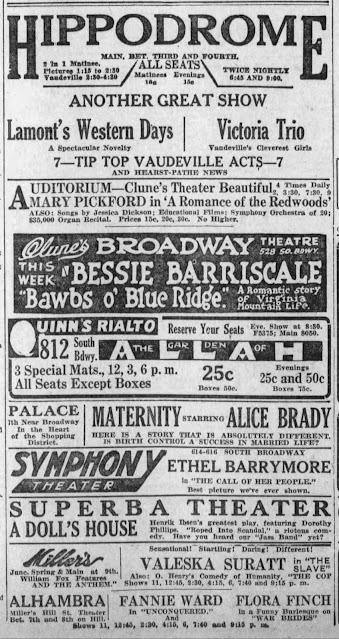





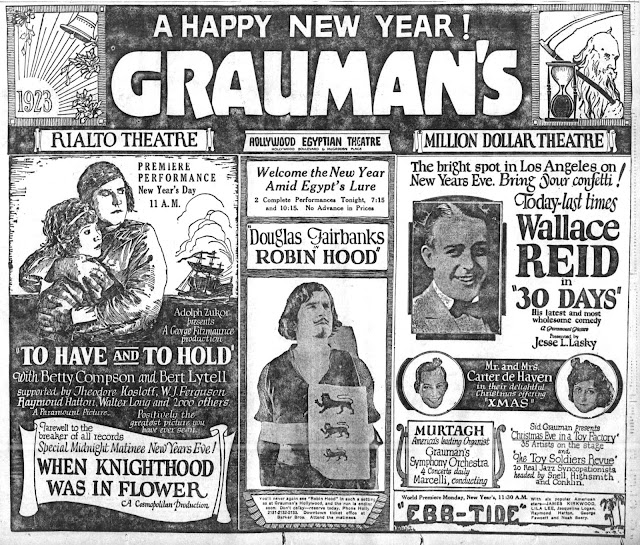







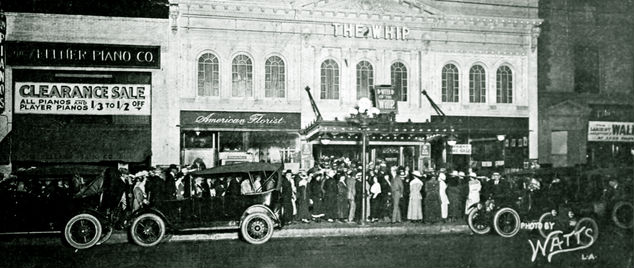




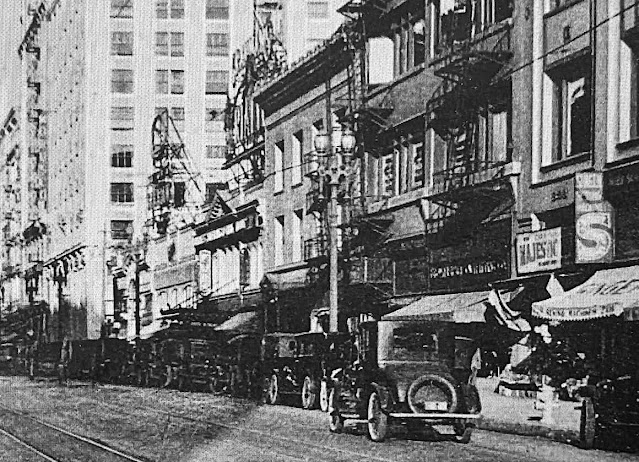










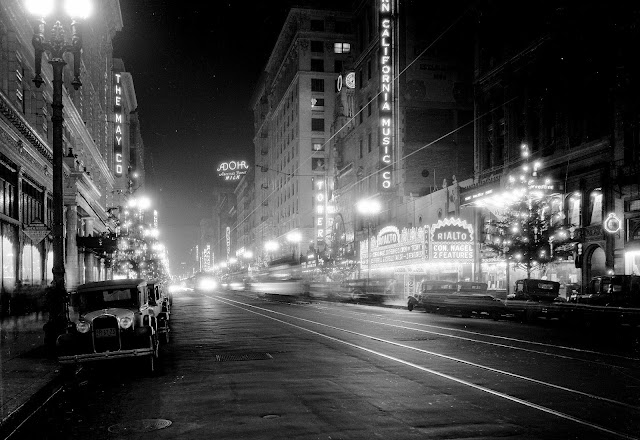



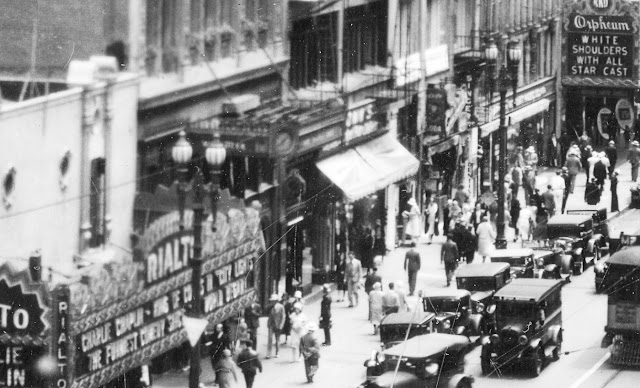

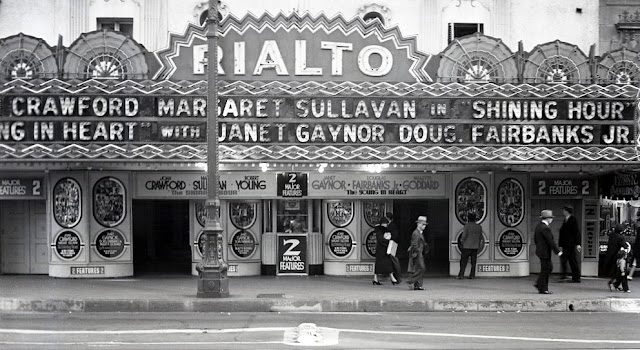














































































No comments:
Post a Comment